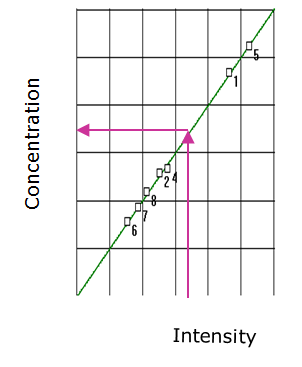6. Quantitative analysis in EDXRF
EDXRF is an excellent technique for qualitative identification of the elements present in a sample. As the intensity of the measured characteristic emission is proportional to the abundance of the element, the technique can be used for quantitative analysis as well. EDXRF is a relative method, which means that a calibration is required to find out the response of the spectrometer to the presence and quantity of the element of interest.
The simplest calibration relating radiation net intensity Ii to weight fraction of analyte wi can be expressed as follows:


where Ki reflects the instrument response (sensitivity) under given operational conditions and bi reflects the presence of some background signal. Ki and bi can be established by the measurement of a set of reference samples, similar by composition to the unknown samples. However, the intensity of the measured fluorescence peaks will depend of several factors, including the nature of the sample and its composition. Linear calibrations are limited to a limited number of cases, since it is not only required that all standards are similar to the unknown, but also a set of standards with a very limited range of concentrations must be applied for calibration. Otherwise the matrix effects in all samples would be different and the linear relationship between radiation intensity and the analyte concentration would be disrupted.
EDXRF quantitative analysis relies in using a sound empirical or theoretical model for the calibration, which should take into account the different interactions taking place in the sample. A general expression relating the relationship between the element weight fraction and the intensity of the measured characteristic emission is derived in the following sections.